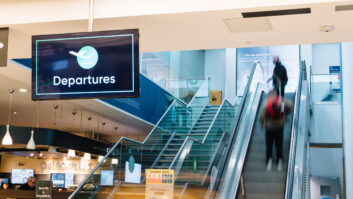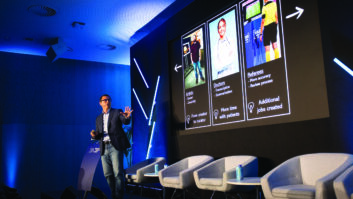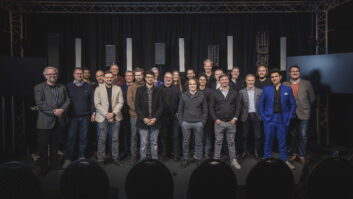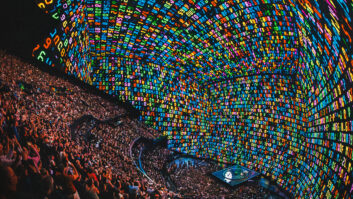Transportation hubs have long been quick to embrace AV technology. Digital signage, video walls, touchscreens and more are all being employed to meet the needs of travellers, writes Ian McMurray.
When a marketing director thinks about advertising, he almost certainly thinks of Google – whether it’s how to ensure his website is optimised for Google searching, or Google AdWords. But what does Google’s marketing director think about? If the company’s October promotion of its ‘cloud’ or web-based Google Apps capability is any indication, he thinks about transportation hubs. Having launched the campaign in the US in August, Google took it worldwide to railway stations in France, Canada, the UK, Japan, Australia and Singapore.
Transportation hubs offer an optimum combination of demographics, dwell time and a desire for information – a combination that the digital signage industry has found to be hugely attractive. In fact, airports, railway stations and other travel centres have long been at the forefront of using audiovisual technology – and, it seems, continue to be so.
“The technology has unquestionably advanced rapidly,” says Yael Elstein, vice president of marketing at
C-nario. “We can deliver multiple content types from multiple sources to multiple destinations – and we’re doing it in high definition with pixel-perfect accuracy and with every frame synchronised to ensure the optimum performance of video walls.”
Richard Wilks, corporate sales manager at NEC, has seen digital signage become increasingly important. “AV displays have transformed themselves from being merely functional devices for communicating transport information, to being used extensively for advertising. That means that the products we’re supplying need to be capable of high-quality graphics, and to be highly networkable – as well as fulfilling the basic requirement of absolute reliability and ease of maintainability.”
“We’re seeing the use of increasingly large displays,” notes Conrac’s Petra Ollhoff, “and thin-bezel solutions to allow flatpanel technology to be used to create seamless video walls. There’s increased use of sunlight-readable displays to counteract the light-flooded design of many new terminals and stations. Touchscreens are becoming more important as passenger self-service allows operators to reduce staffing costs, and to allow greater interactivity with the information that’s available.”
Eric Hénique of eyevis talks about the growing importance of visually communicated rather than audibly communicated information, allowing passengers to obtain the information about their itinerary at the best time for them – and how the “memory effect” that once characterised information screens worldwide is now a thing of the past. He also points to his company’s 7.3mm bezel displays, and the EYE-Sun series of screens that are designed for use in high ambient light environments.
And while growing numbers of terminals are becoming quieter, the need for voice communication has not gone away. “Operators are looking for better intelligibility of paging, voice alarm and evacuation systems,” says Thomas Mittelmann, business development manager at Powersoft, “and so the move is towards higher quality.”
Leading from the front
Transportation hubs, then, are typically at the leading edge in terms of adoption of new audiovisual technologies – but they also place special demands on many – if not all – of the companies supplying them. In some cases, that’s little more than recognition of the fact that these are public areas.
“First and foremost, our products have to be safe,” says Ollhoff. “This means that we use safety-glass panels – which also help protect against vandalism as well as making it possible to clean the screen without damaging the display. It goes without saying that our housings are not only rugged, but also fire-retardant. And, of course, all external controls are out of reach to protect the devices against tampering.” She also points out the importance of long-term product availability to ensure that, if a screen is replaced, it is replaced by one that appears identical.
For Wilks, it’s about recognising the unique installation challenges presented by airports and railways stations, and designing appropriate solutions. “To achieve the functionality our displays need, we use slot-in modules,” he says. “Not only are these more reliable than the traditional PCs or thin clients that would otherwise be used, but they also reduce installation and maintenance costs in environments where the displays are not conveniently located.”
Reliability
Mittelmann notes the contribution to 100% uptime that can be made with inbuilt diagnostics and remote monitoring: inevitably, absolute reliability, with products designed for 24/7 operation, is also a recurring theme. “When you’re talking about safety, you can’t over-stress the importance of reliability,” he says.
Scalability and experience with high traffic-flow environments are among the strengths that C-nario believes it brings. “We use the same base products, but we have the expertise to adapt them for transportation environments,” says Elstein. “For example, we have an airport application that comprises a collage of screens displaying destinations, as well as temperature information and news related to the destinations, and advertisements. Airports can also use C-nario’s interactivity features, using touchscreens, to let passengers get information that’s relevant to them. The application creates a unique experience for people who are waiting for their departure.”
Powersoft deploys its ‘standard’ product into the transportation environment. “Whether it’s optimum audio quality or outstanding reliability you want,” he continues, “it makes no difference whether you’re a rock band on tour or an airport.”
Another company with a similar outlook is Vogel’s Professional. It has a wide range of mounting solutions and develops no specific mounts for transportation hubs. “At the end of the day, a mount is a mount,” smiles Wim Arts, marketing manager. “We believe we have a better solution than our competitors – but just the sheer volumes involved in this market make it incredibly price-sensitive.”
Unique market
And that, of course, raises the question of whether this is a good market in which to be. It seems to have been somewhat immune to the effects of the recession, and for many companies its unique demands mirror their perceived competitive advantages.
“For a medium-sized company like ours, with our own research and development, mechanical design and manufacturing, it is in many ways the ideal market,” says Conrac’s Ollhoff. “The requirement for customisation – special designs and very specific solutions – is exactly where our strength lies. The fact that we’ve been not only active in this business since the late 1960s, but also a pioneer – we were the first company to put plasma displays into an airport back in the late 1990s – tells us we must be doing something right.”
And if C-nario believes that a strength it brings to the market is experience in high-traffic volume environments, so NEC believes its track record in reliability and maintainability stands it in good stead. Expertise in security and surveillance applications, and an understanding of what 24/7 operation and support really mean are advantages that eyevis believes it brings to the transportation table, while, for Powersoft, the most important attribute is product quality in design, functionality and performance.
Of all the transport hub markets, the two most important seem to be airports and railway stations, with road and sea lagging some way behind – the former because, perhaps, it is not a digital signage opportunity, and the latter because it is seeing little growth either in passenger numbers or routes served. The railways are seeing growth because of government investment in a transport infrastructure that is both more efficient and more environmentally sound, while airports continue to compete vigorously to become the departure points of choice.
Both markets are somewhat event-driven, as Wilks notes. “In the UK,” he says, “there has been a focus on refurbishing the rail and air sectors in preparation for the 2012 Olympics.” London’s mayor has outlined a plan that would see all visitors being able to find their way quickly and easily to any Olympic site – providing an exciting challenge for digital signage solutions across the city’s transport infrastructure.
Behind the scenes
But if digital signage and flight information appear to dominate any discussion of audiovisual technology in transport applications, it is far from the only application. Few major airports, for example, don’t have some form of control room both for day-to-day operations and for crisis management. And while front-of-house screens and systems are, by definition, the most visible, similar systems exist unseen in areas such as baggage handling. And then, beyond the terminal building, there are car parks and bus stops. AV technology and solutions are truly pervasive.
Will they become more so? How can we expect the market for audiovisual solutions for transportation environments to develop in the future? It will, of course, almost certainly continue along the same vector it’s been following in recent years – larger, more compelling screens with thinner bezels, higher-quality audio, improved safety and evacuation systems; more pervasive implementation of digital signage and so on.
Other developments are perhaps less intuitive. “We’ll see more interaction between passengers and displays,” says Hénique. “That interaction will rely not only on touch, but also on gesture recognition.”
Elstein takes up the theme. “We expect to see more emphasis on creating a unique passenger experience,” she says, “by using large video walls in the walkways, and other high-impact arrangements of multiple screens that will include interactivity with SMS, touchscreens and so on.”
“The ‘green factor’ will become increasingly important,” adds Mittelmann, “not only because it’s seen to be the right thing to do, but because it is also demonstrated to save money.”
A co-ordinated effort
Perhaps the most interesting speculation, however, comes from Ollhoff. “We expect that the tendency we’ve seen over the past two years will develop even further,” she says. “Suppliers of different equipment and services will increasingly team up to offer a complete solution rather than just their own products and/or services – something that’s very beneficial for customers because project co-ordination becomes a lot easier. That’s something we’ve been doing for quite some time: for example, we offer the Flight Information Display System consisting of the FIDS software and all the display devices, one of our partners offers the IT system, the AODB (airport operational database) and a message broker for communication with external systems, and yet another partner takes care of the public announcements. Further partners might quote for the baggage handling or ticketing services, for example.”
But progress isn’t necessarily good. A source of regret to many is likely to be the gradual demise of old technologies such as the split-flap arrival/departure boards, the unique sound of which was once part of every airport.
“There are various thoughts about possible replacements, one being cluster solutions using some kind of narrow-bezel display,” says Ollhoff. “Another approach uses a hybrid solution combining different technologies, like the large information board we supplied for Brussels airport. It combines split-flaps with LCD displays. The flat screens integrated in the board take care of the graphical part of the information, displaying the airline logos and flight numbers.”
However the market develops, though, as Wilks points out, the fundamental requirements will remain: “24/7 operation, reliability in a hostile environment, easy and low-cost maintenance, and networkability,” he says. “In an environment where audiovisual technology is providing a mission-critical solution, the importance of those characteristics will be undiminished.”







